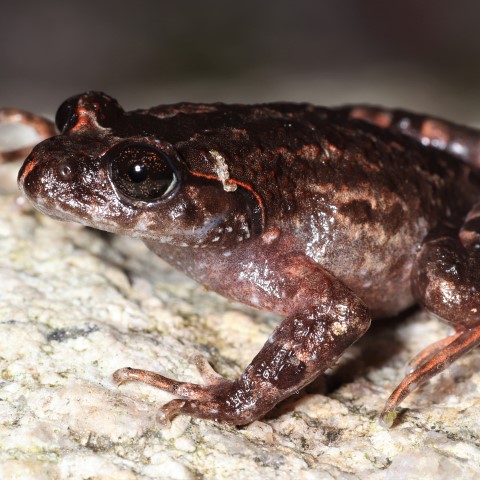Conservation Actions
This species is not known from any protected area, and none of its estimated range is protected. The first step towards ensuring this species' long-term persistence is addressing the lack of data. Further research is needed to determine how much of Khao Chang karst tower is inhabited by the species, whether it occurs in any nearby areas, and how dependent it may be on intact lowland forest. The species' relative abundance, population trend and reproductive ecology need to be better-understood. The effects of nearby palm plantations on the species should also be investigated. It may be necessary to implement some protection of the karst systems surrounding Phang Nga as well as the small areas of remaining adjacent lowland forest.Location Information
This species is currently known only from a single locality at 91 m asl in a Khao Chang karst tower of Mueang Phang-Nga District (erroneously Takua Pa District in the original publication), Phang Nga Province, Peninsular Thailand (Grismer et al. 2017, Anchalee Aowphol and Attapol Rujirawan pers. comm. July 2020). That there are no streams (the typical breeding habitat of Ansonia species) in the immediate area, and this species has only been observed on the tower or in the caves within (Grismer et al. 2017), may indicate that the species is restricted to karst areas. Khao Chang is one of three discrete elevated karst structures immediately surrounding the town of Phang Nga. The other two are approximately 600 m south and 2 km east of the edges of Khao Chang, and have been included as potential parts of the species' range in the map associated with this assessment. The species' estimated extent of occurrence (EOO) is only 4 km2, and its range comprises a single threat-defined location.Geographic Range
Extant
Thailand
Population Information
Very little is known about the size and trends of this species' population except that it was described from two adult males and four adult females (Grismer et al. 2017). Population declines may be occurring due to agricultural practices and development surrounding Khao Chang karst tower. If quarrying is occurring there, or anywhere else where the species is likely to occur, its population trend would almost certainly be affected.Threats
Recent satellite imagery reveals that Khao Chang karst tower is almost completely surrounded by palm plantations. Plantations also extend to much of the edges of the two nearby karst outcrops. Urban development in the township of Phang Nga occupies the space between the three outcrops, and the species' only known locality is approximately 80 m away from cleared land in the town. If this species had historically occupied adjacent lowland forest, it is very unlikely that this is still the case, with the vast majority of the surrounding habitat now being highly modified. The clearing and subsequent development of agriculture in lowland areas is known to indirectly affect adjacent karst systems by reducing the fauna that visit caves (including prey of frogs), polluting subterranean water systems, and increasing the risk of fire (Culver et al. 2000, Robinson and Webber 2000, Clements et al. 2006). Limestone quarrying is also considered a major threat to karst biodiversity and is occurring at higher rates in Southeast Asia than other tropical regions (Clements et al. 2006). Limestone quarrying is ongoing in areas surrounding this species’ only known locality, within Mueang Phan-nga District, and may threaten the species if it occurs outside of this locality (A. Aowphol and A. Rujirawan pers. comm. August 2020).



